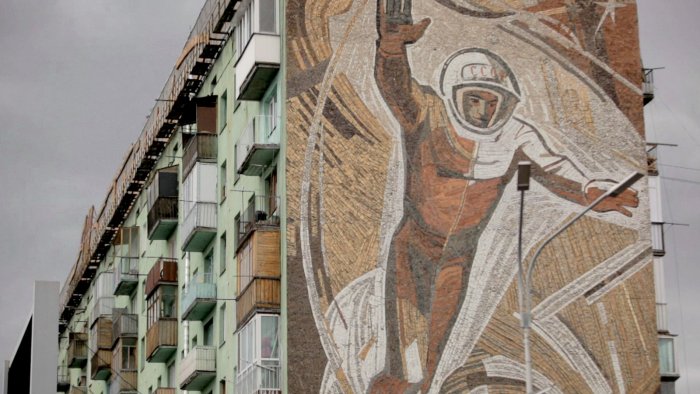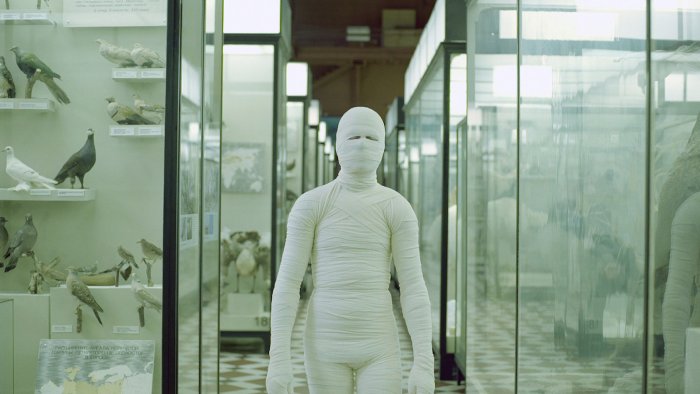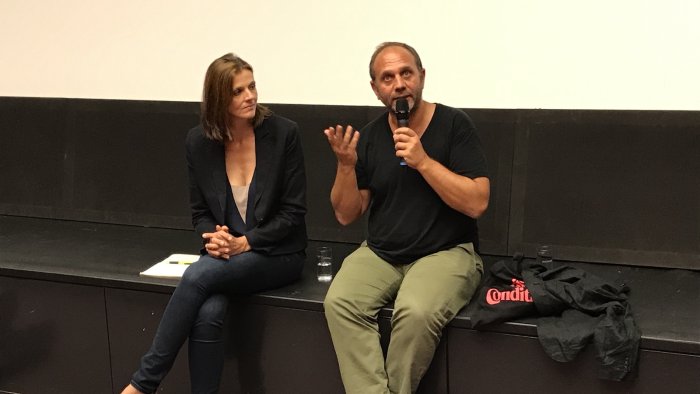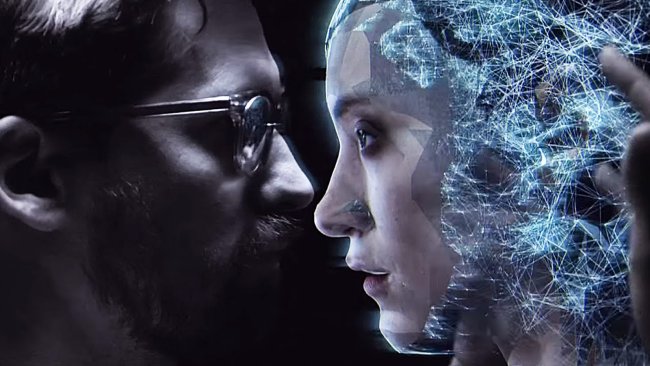Anton Vidokle | Immortality for All
[…] The spiritual and scientific aspects seem to melt together and to have had an important influence historically on the bright and short season of Russian Avant-gardism, revealing one of its hidden sources.
[…] Similar to a living museum, or a space exploration project, the cinema itself can also be conceived of as an instrument of perpetuation, a tile in the cosmist project.
Filmexplorer has taken the opportunity to keep track of the Q&A between Anton Vidokle and Maxa Zoller, curator of the film programme at Art Basel, through improvised media.
Text: Giuseppe Di Salvatore | Audio/Video: Ruth Baettig
“Immortality for all”: that is not the motto of some advertisement for an antiaging product but the main tenet of Russian cosmism and its transhumanist utopia. In his trilogy Anton
Vidokle explores cosmism by focusing on its inspirational guru Nikolai Fyodorovich Fyodorov, according to whom immortality and resurrection are not utopic ideas but urgently needed scientific projects and concrete tasks for humankind to achieve. Starting with a reflection on the principle of the conservation of energy, Fyodorov assumes that death is a mistake that must be amended. In Vidokle’s trilogy we discover the many conceptual and cultural connections of Russian cosmism around the turn of the 20th century through the philosophical line of Fyodorov’s texts, the net of influences of which includes not only the proto-existentialist Andrei Platonov and heroes of literature like Leo Tolstoy and Fodor Dostoevsky, but also pioneers of Russian space exploration like Konstantin Tsiolkovsky or pioneers of heliobiology like Alexander Chizhevsky. The spiritual and scientific aspects seem to melt together and to have had an important influence historically on the bright and short season of Russian Avant-gardism, revealing one of its hidden sources.
Does it stem from a conceptual confusion to think that an individual human being should have the ability to become immortal insofar as a cosmic energy is destined not to be lost? Life itself can be more easily thought of as immortal than specific living organisms can like the human body. Yet the belief in a high degree of cosmic interconnection – an adage as old as Renaissance Neoplatonism – should blur the distinction between the general and the particular, the mineral and the living. Fyodorov’s philosophy seems to respond to the traditional metaphysical and religious challenges of immortality and resurrection in a secular and scientific way. But his positivist approach is not a purely materialistic one, for mental functions (like memory) or cultural values (like books and museums) still play a fundamental role in the cosmist project. More than pure secularism, a form of Gnosticism seems to be strongly implied in Fyodorov’s philosophy.
I have gone into detail on the philosophical questions that constitute Vidokle’s objects of inquiry in his essayistic work because the tension between the material realization of the cosmist project and its psychological or cultural sublimation constitutes, in my opinion, the most important drive of the essay; a drive that speaks just as much for the cinematic aspects of Immortality for All, insofar as the film displays a tension between the physicality of the images and the conceptual line of the voice-over. It is precisely through the combination of these aspects – producing contrasts or conjunctions – that Vidokle’s essay finds its most convincing moments.
If the first two films of the trilogy (This Is Cosmos and The Communist Revolution Was Caused by the Sun) are more focused on the scientific aspects of Russian cosmism, the last film (Immortality and Resurrection for All) brings forward the fundamental role of museums as material vehicles for conservation, memory, and historical perpetuation. It is possible that conservation can equal regeneration only if we believe that our historical consciousness can suffice for the dead to be resurrected. This perspective recalls the Romantic historicism of Johann Gottfried Herder and German idealism in general, or at least its interpretation in terms of Panpsychism – a philosophical doctrine that is still studied today. But the cognitive concentration of this last film does not necessarily require an exclusively intellectual reception of it. Vidokle is always able to balance the perceptual and cognitive in his cinema, and the images of museums effectively ask for a strong involvement of our senses.
One can be intrigued by the Russian Cosmism or criticize it; in its revival, one can see the effort of a Russian filmmaker to find new cultural roots in the post-soviet era or a neo-avant-gardist attempt to dismiss the aridity of materialism in favour of the ideal of a new harmonia mundi. However, one cannot help but recognize Vidokle’s amazing work that succeeds in expressing a philosophical discourse through cinema. Thanks to the suggestive power of utopian machines, the embalmment of animals (…and of Lenin), the Kazakh landscape, the Egyptian traces of sun worshipping, etc., Vidokle adds a presentational force to the representational function of the image. The potential confusion between the concepts of natura and natura morta, of the living and the mineral, becomes an iconic virtue of the cinematic image. Similar to a living museum, or a space exploration project, the cinema itself can also be conceived of as an instrument of perpetuation, a tile in the cosmist project. It would come as no surprise if Vidokle were to dedicate a fourth chapter of his essayistic project Immortality for All to the medium of cinema itself…
This article contains a third-party video. If you would like to watch the video, please adjust your settings.
Info
Anton Vidokle | Shorts | Immortality for All: A Film Trilogy on Russian Cosmism | KAZ-DE-RU 2014-2017 | 96’ | This Is Cosmos (2014) 28’; The Communist Revolution Was Caused by the Sun (2015), 33’; Immortality and Resurrection for All (2017), 34’ | Locarno Festival 2017 | Art Basel Film Programme 2017
First published: August 14, 2017






